4x4 Easy KenKen Puzzles
Kendoku is a numerical puzzle game similar to Sudoku but with a few key differences. It's also known by other names like Mathdoku, Calcudoku, or KenKen. The goal of Kendoku is to fill a grid with numbers according to certain rules.
Recommended: Check out our Printable Puzzle Books Collection to download and print.
Also try these puzzle makers to make your own custom printable puzzles.
Need Help? To get started, check out these instructions, goals and rules for how to solve puzzles
Select a section to filter results:
- 4x4
You are browsing category 4x4 show all
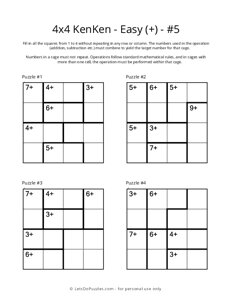 4x4 KenKen - Easy (+) - 5
4x4 KenKen - Easy (+) - 5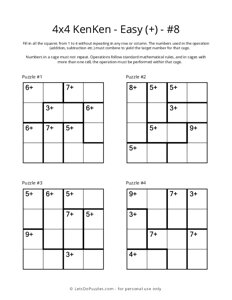 4x4 KenKen - Easy (+) - 8
4x4 KenKen - Easy (+) - 8 4x4 KenKen - Easy (+) - 9
4x4 KenKen - Easy (+) - 9 4x4 KenKen - Easy (+) - 4
4x4 KenKen - Easy (+) - 4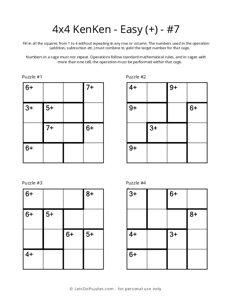 4x4 KenKen - Easy (+) - 7
4x4 KenKen - Easy (+) - 7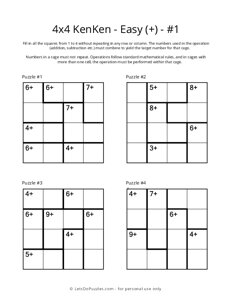 4x4 KenKen - Easy (+) - 1
4x4 KenKen - Easy (+) - 1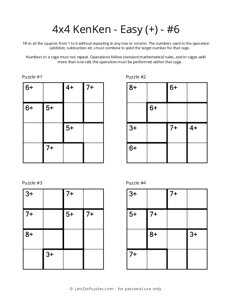 4x4 KenKen - Easy (+) - 6
4x4 KenKen - Easy (+) - 6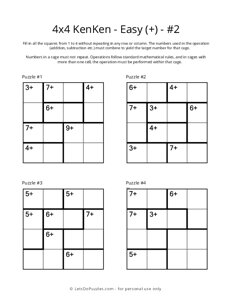 4x4 KenKen - Easy (+) - 2
4x4 KenKen - Easy (+) - 2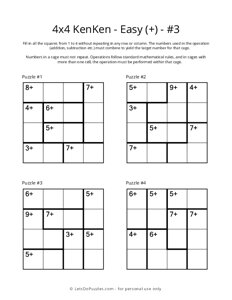 4x4 KenKen - Easy (+) - 3
4x4 KenKen - Easy (+) - 3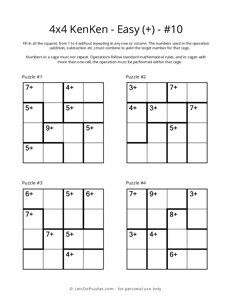 4x4 KenKen - Easy (+) - 10
4x4 KenKen - Easy (+) - 10
Here's how to play KenKen:
- Grid: The puzzle consists of an NxN grid (similar to a Sudoku grid) where each row and column must contain unique numbers from 1 to N.
- Cages: The grid is divided into cages, each containing cells that form a mathematical operation (addition, subtraction, multiplication, or division) and a target number.
- Rules:
- Each row and column must contain unique numbers from 1 to N (N being the size of the grid).
- In each cage, the numbers used in the operation (addition, subtraction, multiplication, or division) must combine to yield the target number for that cage.
- Numbers in a cage must not repeat.
- Operations follow standard mathematical rules, and in cages with more than one cell, the operation must be performed within that cage.
- Solving Strategies:
- Elimination: Start by identifying cells with fewer possibilities. For example, if a cage has a target number of 4 and consists of two cells, those cells must be 1 and 3 (or 3 and 1), as they must be unique and add up to 4.
- Intersection: Look for numbers that appear in the intersection of rows and columns. If a number can only fit in one particular cell within a cage, place it there.
- Mathematical Deduction: Use basic arithmetic principles to eliminate possibilities. For instance, in a cage with a target of 12 and three cells where multiplication is the operation, you cannot have 3x4x4 as it totals 48, so you must deduce a different combination like 2x3x2.
- Iterate and Refine: As you fill in more cells, continuously reevaluate possibilities for other cells based on new information.
- Trial and Error (if needed): Sometimes, puzzles may require trial and error, especially in the later stages. But ensure that any assumptions you make are logical and consistent with the rules of KenKen.
- Practice: Start with smaller grid sizes and simpler puzzles to get the hang of the rules and strategies before attempting larger or more complex ones.
KenKen puzzles challenge both logical reasoning and basic arithmetic skills. With practice and patience, you'll improve your ability to solve these puzzles efficiently. You can find KenKen puzzles in various difficulty levels online or in puzzle books to practice and sharpen your skills.
